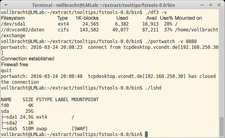Tool Tips
Tool Tips

© Lead Image © Kheng Ho Toh, 123RF.com
Article from Issue 191/2016
Tool tests on the fast track.
Fstools 20160322
Function: Useful script collection
Source: http://fex.belwue.de/fstools
License: GPLv2, Perl Artistic License
[...]
Use Express-Checkout link below to read the full article (PDF).
Buy this article as PDF
Express-Checkout as PDF
Price $2.95
(incl. VAT)
(incl. VAT)
